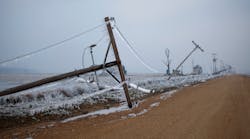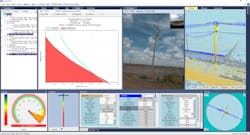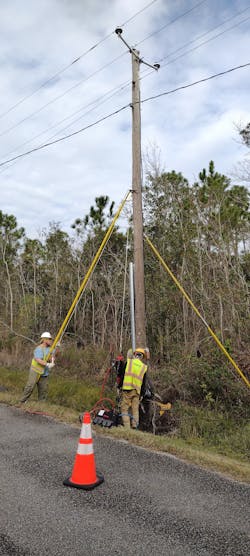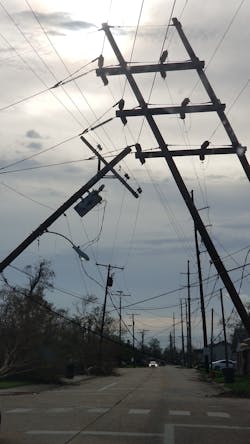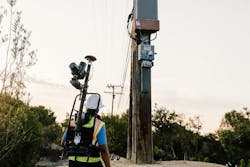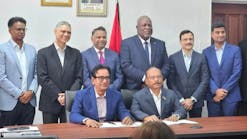Building New Electricity Resilience In the Sooner State
It is not so much when wind comes sweeping down the plains that is problematic for Oklahoma Gas and Electric Company (OG&E), but rather it is ice. An October 2020 ice storm that knocked out power to more than 300,000 customers was the kind of event that changed the way the electric company’s asset management team looks at resiliency. The Sooner State experiences a significant ice event every decade or so, but this storm was unlike any the region had seen in a long, long time.
The University of Oklahoma warned students at its sprawling Norman campus to beware of “lightning-infested sleet and freezing rainstorms.” A thick glaze of ice started to accumulate on roads, buildings, trees and power lines on Monday, Oct. 26, and continued to fall for two days. Gusty winds pulled down ice-covered power lines and trees, many of which were still fully in leaf because of the storm’s early-season arrival.
The media reported on “tree carnage,” with limbs falling incessantly over the course of several days. Forestry crews rushed to Oklahoma City National Memorial Park to prop up the ice-weighted limbs of the Survivor Tree, a memorial American elm that honors the lives lost in the domestic terrorist bombing at the Alfred P. Murrah federal building. Nonetheless, a major limb was lost on the beloved tree.
High-power lines came down across interstates, snarling traffic and cross-country shipping lanes across the heartland. Many surface roads remained impassable for weeks. It took OG&E four weeks to bring the last of its customers back on-line. Oklahoma ranks as one of the top states in the country for weather events and having more than one-half of OG&E’s customers in the dark at one single time was completely unacceptable.
The areas where the company had replaced poles during prior storms saw several failures again in October 2020. OG&E had expected its newer infrastructure to be more resilient to the severe weather. In the months that followed, the company formed a team to examine the root causes of its grid challenges and answer the questions: What can be done to help customers have confidence their lights will remain on in major weather events? And if the power does go off, how could OG&E get it back on quicker?
Customer Focus
The OG&E team wanted real resilience for the grid. The members needed to understand what changes could be made to reduce the severity of future events and shorten the duration of outages. The team thought it had all the necessary data: geographic information system data, span links information and loading analysis. The damage was assessed, numbers were crunched and results were reviewed. However, a complete load analysis of each pole appeared insurmountable.
In the end, the group committed to a deeper understanding of the grid, reassessing what it had been designed to withstand and what practical improvements could be made to improve its weather resilience.
The team sought to have customer-focused situational awareness of the system. It took inspiration from some of the Gulf Coast utilities that have been proactive, investigating and understanding the pole strength and structural loading of each asset in the field and what they can withstand.
With the ever-increasing frequency and intensity of hurricanes in its service area over the last decade, one major Gulf Coast utility shared how it had created a new model of grid resilience for its customers. Working closely with Osmose, this utility had performed an in-depth analysis of the weaknesses in its grid and invested in hardening its pole plant for the long run, building out a system to sustain winds up to 150 mph (241 kmph).
OG&E had experience working with Osmose itself. The company had been performing ground line reviews of transmission structures for several decades. OG&E then contracted with the company on a pilot project of distribution ground line inspections in 2019. Impressed with the company’s technical expertise and diligence, OG&E engaged Osmose to support a more targeted approach to grid hardening.
Even with the many weather challenges in its territory, OG&E customers enjoy some of the lowest electric utility rates in the U.S. That is the result of an adamant focus by OG&E on finding and delivering value for customers. OG&E realized it could deliver the best value for customers by taking a more prioritized, data-driven approach to make the grid truly weather resilient.
Four-Step Process
After an onboarding process to understand OG&E’s specific needs, Osmose rolled out a four-step process to maximize value in making overhead lines more structurally resilient for customers.
The first step involved detailed field data collection using OsmoVision, an Osmose-developed combination of field collection methods and integrated data-processing automation that enables efficient and accurate utility structure modeling. Using a combination of vehicles outfitted with GPS, light detection and ranging (LiDAR), and high-resolution imaging cameras and backpack tools for walkout inspections, Osmose technicians collected highly accurate and automated data for the territory. They went beyond the standard aerial shots and drive-bys. By adding a walkout format with advanced image and LiDAR capture tools in a package technicians could carry into Oklahoma’s diverse terrain, they were able to capture data that exceeds the limitations of vehicle- or aerial-only information gathering. The advanced technology eliminated the need for more traditional and subjective measurement tool sets.
The second step included automated classification and image processing. Using the LiDAR data and imagery collected in step one, Osmose technicians were able to measure heights and distances between poles precisely, identify attachments and create a georeferenced database for all attached objects. Osmose’s proprietary image-recognition tools created valuable automated information that fed pole models in Osmose’s structural analysis engine, O-Calc Pro. This step was key to creating a complete picture of OG&E’s existing grid and understanding where the accumulation of attachments on poles over the years could lead to overload.
In the third step, the O-Calc Pro tool was used to create a complete digital model of OG&E’s pole network, including a comprehensive structural load analysis. The model enabled Osmose to prescribe effective solutions for any found conditions throughout the network and offer efficient remediation options. The model is stored in a secure pole loading database that can offer solutions for future work.
The fourth step provided a pole-by-pole recommendation, considering the remaining strength estimation performed during the evaluation and life-extension treatment process as well as the pole load analysis results. The resulting recommendations included poles that already exceeded the strength required for OG&E’s design loads, poles that should be strengthened using engineered trussing systems and poles that require a stronger replacement. For each pole that failed OG&E’s weather-hardening design criteria, Osmose provided a detailed prescription of the truss system and size required for strengthening the asset or which replacement size was recommended.
Savings And Safety
Even before the 2020 ice storm, OG&E’s grid already met National Electrical Safety Code (NESC) standards for the region. However, to achieve the kind of resilience Oklahoma’s evolving climate reality requires, the electric company must exceed those standards and provide value to its customers.
Although much of this work is ongoing, Osmose estimates it will analyze and harden more than 1200 line-miles (1931 line-km) for this initial effort, encompassing 38 circuits and roughly 49,000 poles. Of those, over a quarter are projected to require strengthening to exceed OG&E’s new loading standards designed to improve resiliency. With Tough Truss installations on over 9000 of these structures, Osmose is estimating a cost savings of up to 65% percent, vs. replacing every identified pole. The pole replacement rate required to bring true weather resiliency to OG&E’s customers is less than 5% of all poles evaluated.
Using the OsmoVision-collected and -processed data, Osmose pinpointed — even on newly constructed lines — which poles would need to be strengthened and prescribed solutions to exceed the prior OG&E pole loading standards, so the assets could better withstand the next major weather event.
Above the savings, safety is central to all OG&E efforts. It has the top safety rating in the Southeastern Electric Exchange and lets that drive its decisions. This applies to everything from how linemen are trained to the material choices for poles. OG&E is currently exploring composite T&D poles to avoid conductive metal infrastructure. As part of building greater grid resiliency, Osmose performed its standard ground-line strength evaluation of poles, which provided added reassurance for OG&E linemen in the field.
Intelligent Approach
Beyond the improved resilience of its grid, OG&E has benefited by strengthening its customer-focused situational awareness of the system to continue providing reliable, life-sustaining, life-enhancing energy solutions. Initially when the team looked at the system, they thought everything looked good and wondered what was missing. After the review with Osmose, they could see what was needed where. Per weather hardening requirements, evaluations are showing that the system can be overstressed by extreme weather events.
The pole-by-pole digital model generated by Osmose using its OsmoVision tool set, O-Calc Pro engineering software and talented pole modeling technicians has given OG&E a deeper understanding of its grid and provided a road map for how to create its own model of resilience, not for tropical hurricanes but for Oklahoma ice storms.
The electric company is making adjustments and progress. Its new resiliency effort is confirming with data and analytics what it suspected, and it is leveraging all the information it has and the expertise of Osmose to make sure it is on the right path.
Based on this intelligent approach, OG&E has become an industry steward in future proofing its grid infrastructure, anticipating and building additional capacity, upgrading its assets for harsher conditions beyond basic code requirements, and preparing to scale to meet the needs of shifting customer demands and climate conditions.
BOBBY SHAFFER ([email protected]) is the manager of Asset Management at OG&E. He has served in this position for the last four years. Prior to this he was the distribution reliability engineer responsible for asset lifecycle and reliability for the distribution system. His team designed and built the grid modernization and enhancement programs, business case analyses and benefits reporting as well as establishing rigorous methods for inspecting, tracking and determining system strength and resilience.
For More Information
Osmose | www.osmose.com
Bobby Shaffer
Bobby Shaffer ([email protected]) is manager of asset management at Oklahoma Gas & Electric.
